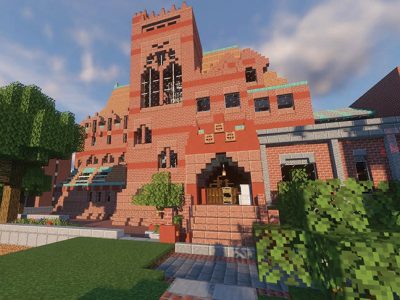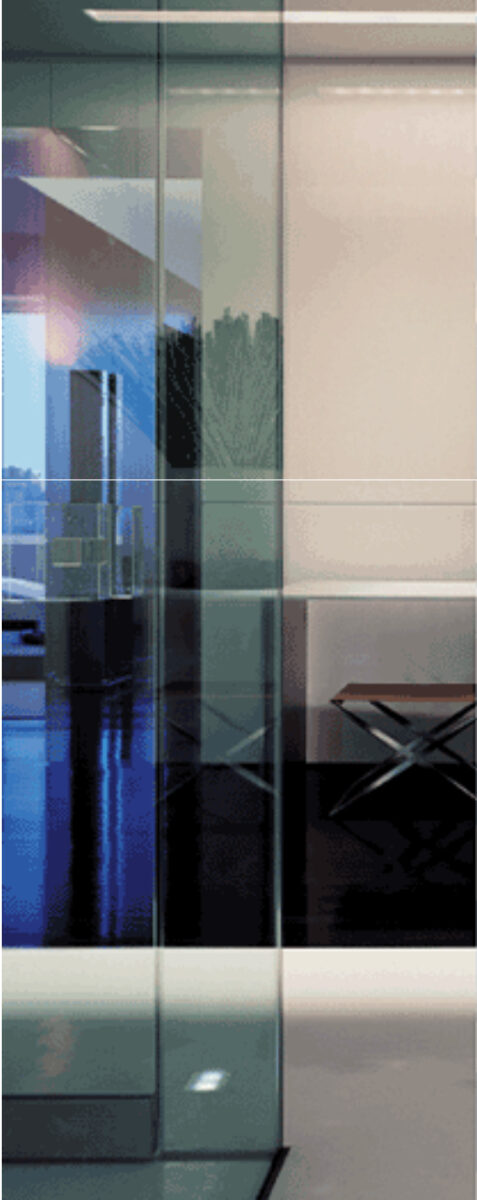
Architects Peter Shelton and Lee Mindel design interiors that are as striking as they are “eminently livable.”
By David Perelli
Function reigns supreme in the New York office of Shelton, Mindel & Associates. Bare cinder-block walls frame arresting views of the New York skyline. Carefully crafted presentation models of buildings clutter the conference room. Even the office dimensions are chosen to provide clients with a ready visualization of standard heights, lengths, and widths. But something else is at work beyond mere practicality: an aesthetic sensibility that borders on the visionary.

Since Peter L. Shelton C’68 and Lee Mindel C’73 founded the firm in 1978, it has garnered 16 citations from the American Institute of Architects, numerous awards for product design, membership in Interior Designmagazine’s Hall of Fame, and a place among Architectural Digest’s top 100 interior designers. Through meticulous attention to detail and a willingness to take risks, Shelton and Mindel have developed an impressive reputation for fusing architecture and interiors. Although the theoretical rigor of their approach often produces highly personal results, they bring only their formidable skills and taste to a project—not a desire to impose.
“They approach each project fresh, without a preconceived idea of what a building should be, what a space should be,” says Louis Oliver Gropp, former editor-in-chief of both House and Garden and House Beautiful. “And they always relate it to where it is.” Consequently, Shelton and Mindel have never developed a trademark “look.”
“There isn’t one,” Gropp admits. “But there is, in another way. There is always a very clean quality to their work. There are usually some surprises, some sophisticated humor often; but also a very high level of seriousness. It is always highly designed.”
Highly designed—but never encumbered by design. “They do very livable architecture,” Gropp observes. “Many architects will design spaces that are beautiful as objects but often problematic as living spaces. Lee and Peter do think about how you’re going to live in that space—and their spaces are eminently livable.”
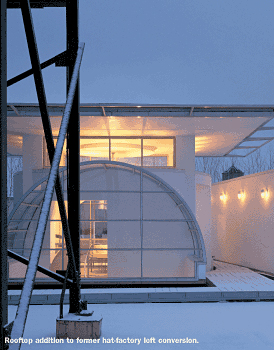
Though they don’t remember much about their initial meeting, Shelton and Mindel do recall that they met as undergraduates at Penn—specifically, in a studio taught by landscape painter Neil Welliver. “The period when we were there was so spectacular, and we didn’t even realize it,” recalls Mindel, a former liberal- and fine-arts major, of a time when the faculty included the likes of Louis Kahn Ar’24 Hon’71, Mario Romanach, Robert Engman, and Frank Kawasaki. “The fact that Peter and I both went to Penn has played a very big role in our lives. The best people in the world were in Philadelphia then.”
Both went on to different architecture schools—Mindel to Harvard, Shelton to Pratt. Several years later, by coincidence, they found themselves co-workers at the New York firm Edward Durell Stone. The job market at the time was bleak, however, and there seemed little opportunity for advancement or self-expression within the large firm. Eventually, the two young architects—each inspired by the other’s creativity, drive, and originality—began a freelance collaboration.
A near-disaster brought the fledgling partnership its first client. “I was on an airplane that had been grounded—in Philadelphia, of all places—because of bad weather,” recalls Shelton. “Finally, they said it was clear to go on to New York, and as we started to take off, there was this huge explosion. The whole plane shook, and then slowed down; it seemed to be veering to the left, then the right. I saw one of the stewardesses standing with her hand on the emergency door, and this young woman sitting next to me started getting really upset.”
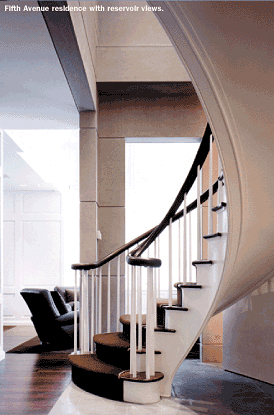
Once the plane was safely airborne, Shelton struck up a conversation with his frazzled neighbor. “She said she had an apartment on Fifth Avenue, and wanted to do some things with it, so we got together,” he recalls. “Then it turned out that her neighbor was the movie director Brian DePalma, and we ended up getting his place. So the practice really became what person you fell across next.”
Their renown has grown along with their client roster: Prominent shelter magazines frequently publish their residential projects, and it would be difficult to find a book on influential contemporary interiors that doesn’t mention their work. Their contract projects include ocean liners, the world’s largest disco, and corporate headquarters for Fila and Ralph Lauren. They’ve designed lighting for Nessen and elegantly minimal plumbing fixtures for WaterWorks. But regardless of the scale or nature of a project, they approach each one with the same discipline and insight, combining to achieve their trademark synthesis of architecture and design—or, as Mindel puts it, “creating space, not just filling it.”
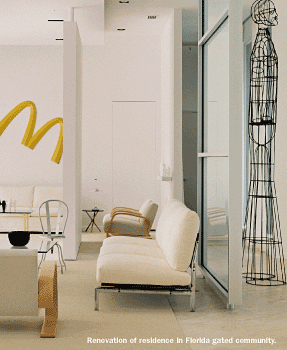
In the early 1980s, V’Soske, the noted manufacturer of fine rugs, asked Shelton and Mindel to contribute a design to a series of exhibition pieces by contemporary architects. V’Soske’s clients have included many of the 20th century’s great architects. All work is done by hand, and V’Soske works only with design professionals. Shelton and Mindel have developed a close working relationship with the firm over the years; several of their rugs hang in its showroom. One, for example, was created for a penthouse apartment surrounded by a garden terrace; it features a stylized depiction of a hedgerow, remarkable for its subtle combination of texture and color.
“How easy it appears when they do something—but they don’t do anything without thinking it through,” observes Roger McDonald, a creative director at V’Soske. “They have such incredible minds,” he adds, gesturing towards the rug. “It comes from the intellect.”
“Not all architects understand how to fully realize the interiors of their spaces—and this is something that Lee and Peter do extraordinarily well,” says Ellen Herzmark, V’Soske’s other creative director. “The architecture and the interior are a perfect union, and that’s quite miraculous.”
The average Shelton Mindel project takes about two years to complete, and they divide the creative process into three phases. “The procedure is the same in everything, whether you’re designing a fountain pen or a skyscraper,” Shelton explains. “We always start with what’s given: Is it an existing place? What are the pros and cons? Then you gather information from the client. When the client is a couple, it’s even more confusing because they say different things—he says, ‘Don’t listen to her’; she says, ‘Don’t listen to him’—and then, eventually, you have a feeling for what sort of a cake this is going to be.”
At this point in the process, Shelton and Mindel formulate a partie, a succinct mission statement expressing their goals for a space, against which they weigh all subsequent design ideas. If an idea undermines the partie, they discard it. “You sort of winnow through as you keep elevating all the layers,” Shelton continues, “and you keep going back to it all the time, so details stay consistent.”
The minutiae of technical specifications follow the creative work.
“Today, construction documents have become monumental,” says Shelton, a little wearily. “With an average apartment renovation, there are over 40 pages, specifying every detail—what screws, where, what paint, painting methods; and the contractor asks you every single question, so it takes a huge amount of time. We also mock up everything—for instance, an island in a kitchen. Is it too far? Is it too close? In some places, one-eighth of an inch is a big deal. Dimensions are very important for circulation and the feeling of spaciousness.”

The firm’s dimensions are likewise significant; it has remained tiny by design. “We’re still trying to make ends meet all the time,” says Mindel, “but we never wanted to get so corporate that we lost touch with our kookiness and our passion—so consumed by our business that we felt disconnected from it. I used to feel really inferior about being so by-the-seat-of-your-pants and small, and then I realized that you don’t have to be big to be great; you don’t have to be small to be great—you just have to be committed to what feels right for you. I’m always proudest of the next project, because you’re always afraid there’s not going to be one.”
“It’s a tough business,” Shelton muses. “If you’re a lawyer, you can say to somebody, ‘Listen to me, or you’re gonna go to jail.’ If you’re a doctor, it’s, ‘Listen to me, or you’re gonna die.’ And then an architect says, ‘Listen to me, or your friends won’t like your place’—it’s just not the same threat.”
In the end, the satisfaction of a job well done is the best reward. “The biggest compliment to us is for clients to just enjoy their place,” says Shelton. “We run into them, and they say it’s been great, they love living there. That’s one of the nicest things we can hear.”
David Perrelli C’01, a contributor to the Gazette since his work-study days, is currently studying at the New York School of Interior Design.



